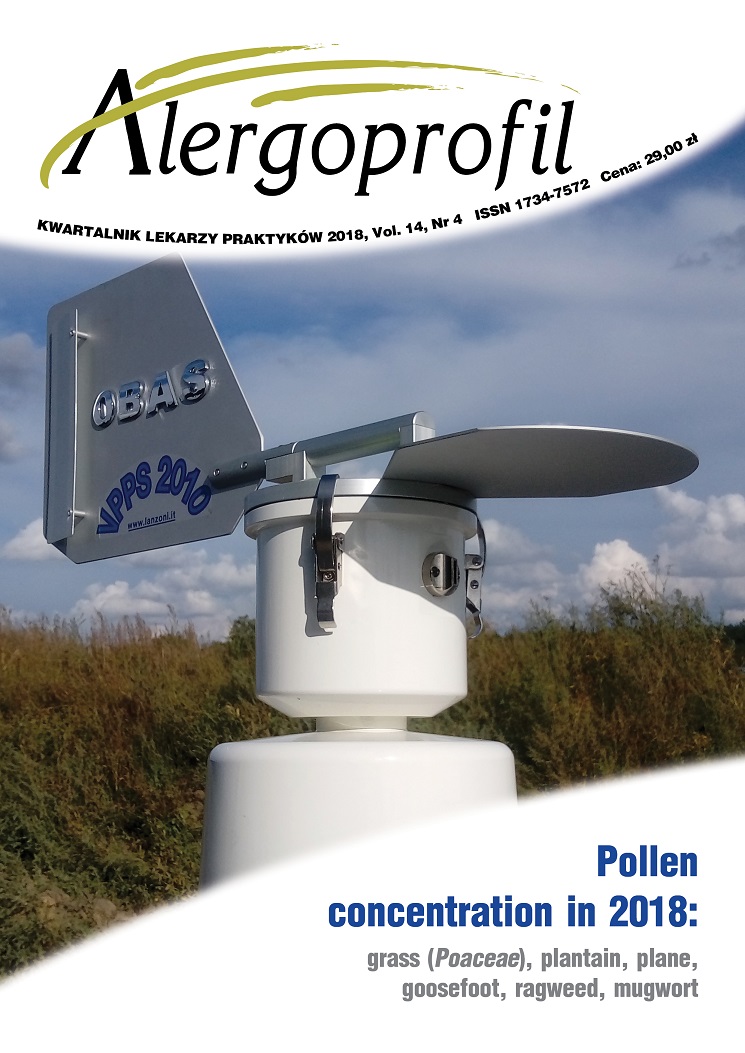Ambrosia pollen season in selected cities in Poland in 2018
##plugins.themes.bootstrap3.article.main##
Abstrakt
Ambrosia causes most pollen allergies in North America. After several Ambrosia species were introduced to Europe, an increase in the incidence of allergy to pollen of these plants has been observed in many countries. The aim of this study was to compare Ambrosia pollen seasons in 2018 in 13 cities located in different regions of Poland: Bialystok, Bydgoszcz, Cracow, Drawsko Pomorskie, Lublin, Olsztyn, Opole, Piotrkow Trybunalski, Sosnowiec, Szczecin, Warsaw, Wroclaw and Zielona Gora. The study was conducted by the volumetric method using Burkard or Lanzoni pollen samplers. The pollen season was determined by the 98% method. The earliest pollen season start dates (the end of July) were recorded in Zielona Gora, Bydgoszcz, Opole and Szczecin, while the latest ones in Drawsko Pomorskie and Bialystok. The longest pollen seasons occurred in Opole, Szczecin and Zielona Gora (79 days). The highest average daily concentrations of Ambrosia pollen were recorded in Bialystok (129 P/m3) and Lublin (99 P/m3), while the lowest ones in Drawsko Pomorskie and Szczecin (4 and 10 P/m3, respectively). The annual pollen sum reached the highest value in Opole (567 pollen grains) and Zielona Gora (555 pollen grains). It can be concluded from the pattern of Ambrosia pollen seasons at the monitoring sites studied that pollen of this taxon originates not only from Ambrosia locations in Poland but also from long-distance transport.
Pobrania
##plugins.themes.bootstrap3.article.details##
Copyright: © Medical Education sp. z o.o. This is an Open Access article distributed under the terms of the Attribution-NonCommercial 4.0 International (CC BY-NC 4.0). License (https://creativecommons.org/licenses/by-nc/4.0/), allowing third parties to copy and redistribute the material in any medium or format and to remix, transform, and build upon the material, provided the original work is properly cited and states its license.
Address reprint requests to: Medical Education, Marcin Kuźma (marcin.kuzma@mededu.pl)
Bibliografia
2. Rapiejko P. Alergeny pyłku roślin. Medical Education, Warszawa 2010.
3. Makra L, Juhász M, Béczi R, Borsos E. The history and impacts of airborne Ambrosia (Asteraceae) pollen in Hungary. Grana 2005, 44: 57-64.
4. Makra L, Amtyasovszky I, Baliant B. Association of allergic asthma emergency room visits with the main biological and chemical air pollutants. Science of the Total Environment 2012, 432: 288-296.
5. Smith M, Skjøth CA, Myszkowska D et al. Long-range transport of Ambrosia pollen to Poland. Agricultural and Forest Meteorology 2008, 148: 1402-1411.
6. Chłopek K, Dąbrowska-Zapart K, Tokarska-Guzik B. An assessment of the Ambrosia L. Pollen threat at a regional scale using the example of the town Sosnowiec (Silesian Uplands Poland). Acta Agrobot 2011, 64(2): 51-62.
7. Jarái-Komlódy M, Juhász M. Ambrosia elatior (L.) in Hungary (1989-1990). Aerobiologia 1993, 9: 75-78.
8. Piotrowska-Weryszko K, Weryszko-Chmielewska E, Voloshchuk K et al. Ragweed (Ambrosia L.) pollen in aeroplankton of Lublin (Poland) and Lviv (Ukraine). Acta Agrobot 2013, 66(3): 3-10.
9. Rutkowski L. Klucz do oznaczania roślin naczyniowych Polski niżowej. PWN, Warszawa 2004.
10. Zając A, Zając M (eds). Atlas rozmieszczenia roślin naczyniowych w Polsce. Pracownia Chorologii Komputerowej Instytutu Botaniki Uniwersytetu Jagiellońskiego, Kraków 2001.
11. Miguel AG, Taylor PE, House J et al. Meteorological influences on respirable fragment release from Chinese elm pollen. Aerosol Sci Technol 2006, 40: 690-696.
12. Dechamp C, Rimet ML, Meon H, Deviller P. Parameters of ragweed pollination in the Lyon’s area (France) from 14 years of pollen counts. Aerobiologia 1997, 13: 275-279.
13. Jäger S, Litschauer R. Ragweed (Ambrosia) in Austria. In Ragweed in Europe. 6th International Congress on Aerobiology, 1998, Perugia, Italy.
14. Richter R, Berger UE, Dullinger S et al. Spread of invasive ragweed: climate change, management and how to reduce allergy costs. Journal of Applied Ecology 2013, 50(6): 142-1430.
15. Taramarcaz P, Lambelet C, Clot B et al. Ragweed (Ambrosia) progression and it’s health risks: will Switzerland resist this invasion? Swiss Med Wkly 2005, 135: 538-548.
16. Piotrowska-Weryszko K, Weryszko-Chmielewska E, Lipiec A et al. Ragweed pollen season in southern Poland in 2016. Alergoprofil 2016, 12(4): 182-185.
17. Puc M, Kotrych D, Rapiejko P et al. Ragweed pollen season in the cities of northern Poland in 2016. Alergoprofil 2016, 12(4): 178-181.
18. Weryszko-Chmielewska E, Piotrowska-Weryszko K, Rapiejko P et al. Analiza stężenia pyłku ambrozji w wybranych miastach Polski w 2014 r. Alergoprofil 2014, 10(4): 35-40.
19. Weryszko-Chmielewska E, Piotrowska-Weryszko K, Rapiejko P et al. Analiza stężenia pyłku ambrozji w wybranych miastach Polski w 2014 r. Alergoprofil 2014, 10(4): 35-40.
20. Kasprzyk I, Myszkowska D, Grewling Ł et al. The occurrence of Ambrosia pollen in Rzeszów, Kraków and Poznań, Poland: investigation of trends and possible transport of Ambrosia pollen from Ukraine. Int I Biometeorol 2011, 55: 633-644.
21. Weryszko-Chmielewska E (ed). Pyłek roślin w aeroplanktonie różnych regionów Polski. Wydawnictwo Akademii Medycznej w Lublinie, Lublin 2006.

